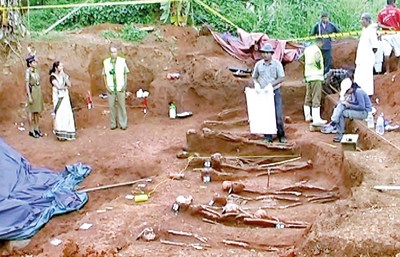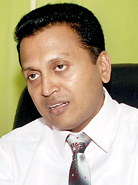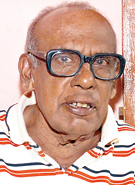News
It remains to be seen and probed
The more human skeletons they unearth, the more the mystery deepens.�Archaeology experts, Police officers and those from the Government Analyst’s Dept, shielded by canopies, are digging a patch of grassy land, a few hundred metres away from Matale’s main base hospital. As I watched last Friday, the count was 53 skeletal remains of men, women and perhaps even children. They had been neatly stacked in three different layers, one on top of the other, with sand, ash and lime in between. The workers have dug only 12 feet so far.

More skeletons are being unearthed: The mystery gets deeper and deeper. Pix by Mahesh Keerthiratne
The find was the result of workers digging the area to build a bio gas tank costing some Rs. 1.2 million, to store hospital waste. The gas is to be used as fuel for the hospital’s kitchen.
Theories of how the skeletal remains came about are many. However, Matale’s Judicial Medical Officer Dr. Ajith Jayasena says, “It is too early to come to conclusions. The probe is continuing.”
“At the moment, we are currently in the process of retrieving the skeletal remains, pending further examination, and towards this end, experts from even the Archeology Department and other medical sectors have been pressed into service,” he said.
According to Dr. Jayasena, it was too early to come to a final conclusion, because so much more has to be done, as this will take between four to eight weeks of thorough examination of these human remains, before a final report could be issued.
He added that archaeology experts had also been called in to test soil samples and other particles found inside the grave, to pinpoint the date of burial. “If necessary, foreign experts will also be called to assist in the probe,” Dr. Jayasena said.
Prof. Raj Somadeva, head of the Postgraduate Institute of Archaeology at Kelaniya University said he had visited the site and collected various items from the soil, including fragments of skeletal remains for closer examination.“We need to re-construct the deposition level of the grave from the date to the weather pattern, when the people were buried. It is possible to reach the exact period of time that the grave has been in existence, but before this could be done, more time is needed for processing the available data,” Professor Somadeva said.
He added that, if necessary carbon dating will also be carried out, if there are indications that the grave is over a 100 years old.
Matale Base Hospital head Dr. Arjuna Tillekeratne concedes the absence of records to indicate death of a large number of people in a small pox outbreak, when the disease was considered lethal.
Such records were never maintained in the early years. Furthermore, the hospital is not a part of the investigations on the grave, but rather, provides assistance to those involved.
“Anything could have happened in the early part of the 19th century, or even earlier, but there is nothing we can go on, as there are no records, despite the fact that the hospital is over 100 years old,” Dr. Tillekeratne said.
 Matale Base Hospital head Dr. Arjuna Tillekeratne. Pix by M.D. Nissanka |
 L.B. Herath,former attendant at the Matale hospital |
However, the absence of a credible and plausible reason, has given rise to various theories such as that the deaths may have taken place during the days in 1848 when Weera Puran Appu was being hunted by the authorities, to an outbreak of small pox disease in 1947, to the abortive armed uprising of the Janatha Vimukthi Perumuna (JVP) in 1971.
I spoke with residents in the area. Some related farfetched stories, whilst others chose not to speak.
Dr. Mirando Obeysekera, PhD scholar and former lecturer at the Colombia Pacific University in the US, is convinced that the skeletons are the remains of those involved in a bloody native uprising led by the legendary Weera Puran Appu in 1847, against the British.
“The remains are in good condition, despite the many years, because the soil in that area is very damp throughout the year, and helped in the preservation of the skeletons,” Dr. Obeysekera told the Sunday Times.
He fails to find any other explanation for the grave, saying that the bodies had been buried on a single day, as the skeletons were found neatly stacked in three different rows. “Ad hoc mass graves would not have such a pattern, and if a disease had struck down the victims, they would die in stages, not in a single day,” Dr. Obeysekera argued.
However, he conceded that with present-day experts working on the findings, they should be able to give a clearer picture, and their findings should be respected.
However, 80-year-old L.B. Herath, who worked as an attendant at the Matale hospital from 1951 to 1987, has another claim.
He said, his father H.M. Kiribana who also worked at the same hospital as an attendant during the colonial era, had told him of an incident where a large number of people had died of small pox.
This happened sometime in the 1947-48 at the infectious disease ward, when the entire hospital was fenced off and no one allowed to leave or enter the premises.
“My father stayed on the premises without a break for three months, while the authorities provided our home with the basic needs and my father’s salary.
”My father later informed us that the wards were overcrowded with the sick and two makeshift wards of cadjan were built to house the overflow.”
He ruled out that the skeletal remains belonged to the insurgents in the abortive 1971 uprising against the State, as suggested by certain individuals.
The Army did maintain a makeshift camp inside the hospital premises at that time, but there was never any sign of bloodletting, shooting, etc. “If that was the case, we would be well aware, as the Army unit was camped inside a semi-constructed maternity ward in the middle of the hospital,” he added.
The same view was held by Sidharampillai Maniamma who worked as a female attendant at the hospital during that period and resigned in 1996. “The Army was there for three months, but there was no violence in any form,” the mother of three recalled.
“The present gravesite was overgrown with shrub and there was no necessity for anyone to go there,” she said adding that those who died during the 1971 uprising were apparently buried at the cemetery situated some 200 metres from the hospital.
Recorded history of Matale also confirms the outbreak of small pox sometime during 1947/48, where several people are reported to have perished.
The JVP, for its part has claimed that the grave contained the remains of fallen comrades, alleging the arbitrary killing by the State’s security agencies during the 1971 uprising. The local police have been ordered against speaking to the media. I was asked to get in touch with their spokesman in Colombo. However, a source at the Matale Police told me that a report was being awaited from the experts, before a formal probe commenced.
In Colombo, Police spokesman Senior Superintendent (SSP) Prishantha Jayakody said the matter will be thoroughly investigated once the experts hand over their findings to court.
Military spokesman Brigadier Ruwan Wanigasooriya said that as the matter was being investigated by forensic experts, he could not comment until their findings are known.
At the time this newspaper went to print the count of skeletons had gone upto 60.
In case of a lucky strike
The National Gem and Jewellery Authority has been requested to send officials to be present at the excavation site.
“This was done because the soil from the grave is being shifted to a nearby river, to search for tiny particles such as teeth, etc, and there could be gem finds in the process.
The Matale basin and the surrounding areas are traditionally known for gem deposits and anything could surface at the gravesite,” Matale Hospital Director Dr. Ajith Jayasena said.
“So now, we have the police and men from the gem authority present during the soil shifting process, to counter silly accusations that may crop up from certain quarters,” he added.
(Additional reporting by Mahesh Keerthiratne and Hilton Berenger)
Follow @timesonlinelk




















